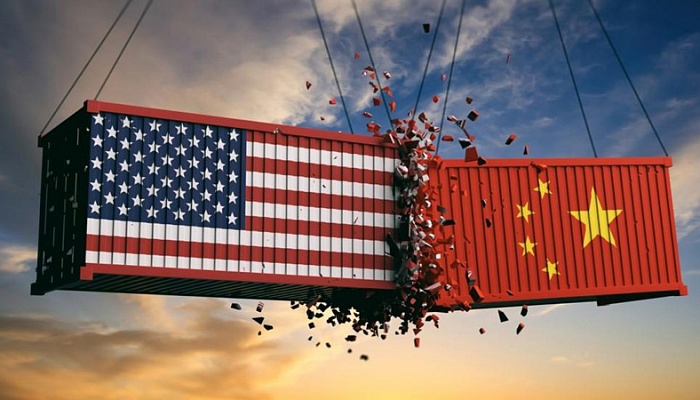What is a Trade War?
A trade war is when a nation imposes tariffs or quotas on imports/goods and the foreign countries that supply those goods retaliate with similar forms of trade protectionism. As it escalates, many things are tariffed/blocked from trading resulting in a trade war. Basically trade wars cause reduced international trade and can negatively impact many different economies. As of mid 2018, the People's Republic of China and the United States of America have been engaged in a trade war through increasing tariffs and other measures on goods.
Trade War? Yay or Nay.
A trade war tends to start when a nation attempts to protect its domestic industries and create jobs. This is directly related with what president Trump had promised his voters, however this tends to only work in the short run. Tariffs are supposed to give a competitive advantage to domestic producers (in country) and thus the prices of those goods would be lower by comparison. Ideally this would result in more business from local customers within the country. The idea behind this would be that as the business grows from within the country more jobs would be created. Although Trump followed this idea when imposing tariffs and taxes on foreign imports, the long run result of a trade war involves the loss of jobs. Trade wars depress economic growth for all countries involved and also triggers inflation when tariffs increase the prices of imports.
Inceased Cost & Losses
As a result of the U.S. trade wars that have been going on, tariffs on steel, aluminum, and lumber have affected the lives and well being of many Americans that depend on selling these goods. The tariff that the U.S. imposed on Canadian lumber have ultimately resulted in an increased cost for developing homes in the U.S., adding up to $9,000 in cost per home. As the demand for lumber continues to increase due to high demand and low supply, the cost of creating buildings and houses continue to increase.
Meanwhile, many American citizens such as farmers are also paying the price for the trade wars that the U.S. have been fighting. According to the Federal Reserve, it is estimated that Trump's tariffs are costing the average American household $1,245 per year. Farmers in particular have been suffering from the retaliatory tariffs impossed by China and Europe on American exports, resulting in high levels of bankruptcies in farm areas of the country. Although Trump has provided aid for the farmers to compensate their loses, other countries are starting to form strong trade agreements and relationships. For example, the EU upgraded its trade agreement with Mexico, removing close to all tariffs that were originally imposed. In addition to this, the EU also signed an agreement to reduce and end tariffs on almost all goods with Japan.

Major Trade War Events (U.S. vs China)
- January 22, 2018: President Trump imposes tariffs and quotas on important Chinese solar panels and washing machines.
- March 8, 2018: Trump asks China to develop a plan to reduce trade deficit by $100 billion.
- March 22, 2018: Administration announces tariffs on $60 billion of Chinese imports stating China uses cybertheft, espionage, and government pressure to obtain leading-edge technology.
- March 23, 2018: China announces tariffs on $3 billion of U.S. fruit, pork, recycled aluminum, and steel pipes.
- March 26, 2018: Administration begins negotiations with China, asking China to reduce tariffs on U.S. automobiles, import more U.S. semiconductors, and grant greater access to its financial sector.
- April 3, 2018: Administration threatened 25% tariff on $50 billion in Chinese electronics, aerospace, and machinery.
- April 3, 2018: China announces 25% tariffs on 106 U.S. exports.
- April 5, 2018: Trump threatened tariffs on $100 billion more of Chinese imports (covering 1/3 of U.S. imporst from China).
- April 10, 2018: China announced it would reduce tariffs on imported vahicles.
- April 18, 2018: China penalizes two other U.S. exports: sorghum and Boeing airplanes targeting industries in the U.S. that supported Trump. Removed sorghum tariffs on May 18.
- May 2, 2018: China cancels all U.S. soybean import contracts. Replaced U.S. beans with those from Brazil, hurting U.S. market.
- May 4, 2018: Administration asked China to reduce trade deficit by $200 billion and cut tariffs on U.S. goods by 2020. Asked China to end subsidies to tech companies, stop stealing U.S. intellectual property, and become more open to U.S. investment.
- May 15, 2018: China agrees to allow Qualcomm to acquire NXP. In exchange, the U.S. would remove tariffs on Chinese telecom company ZTE.
- May 21, 2018: China agrees to cut tariffs on U.S. auto inports from 25% to 15%, going into effect July 1.
- May 29, 2018: Administration said it would target $50 billion in imports from China, restricted Chinese acquisition of U.S. tech.
- July 6, 2018: U.S. tariffs went into effect for $34 billion of Chinese imports. China retaliates with 40% tariff on U.S. autos and tariffs on U.S. agricultural exports. Tesla announces it will build a factory in Shanghai to avoid tariff.
- July 11, 2018: Administration announces 10% tariffs on another $200 billion of Chinese imports. Threatens 25% tariffs after Jan 1, 2019 on consumer goods.
- August 2, 2018: Administration announces a 25% tariff on $16 billion worth of Chinese goods, China retaliates same way targetting autos and coal.
- September 18, 2018: Administration announces tariffs on $200 billion of Chinese imports.
- December 1, 2018: President Trump and President Xi Jinping meet at G-20 conference. Trump agrees to delay 25% tariff increase from Jan 1, 2019 to March 1, 2019.
- January 18, 2019: China agrees to increase its purchases of U.S. exports and reduce the trade deficit.
- February 27, 2019: Administration drops threat of imposing 25% tariff that was going to start March 1.
- May 20, 2019: Trump imposes fourth tariff, raised tariffs to 25% on $200 billion worth of goods.
- To be continued...
Overall Affect & Bottom Line
The trade war has resulted in an increase in prices of consumer goods using steel and aluminum while at the same time increasing the cost of imports from overseas. The thing to understand is that although a trade war may improve a nation's trade deficit in the short run, it could also cost a decrease in economic growth in the long term. The U.S. is currently engaged in a trade war with China, the EU, Mexico, and Canada resulting in those countries signing trade agreements with one another and leaving America out of the deals.










